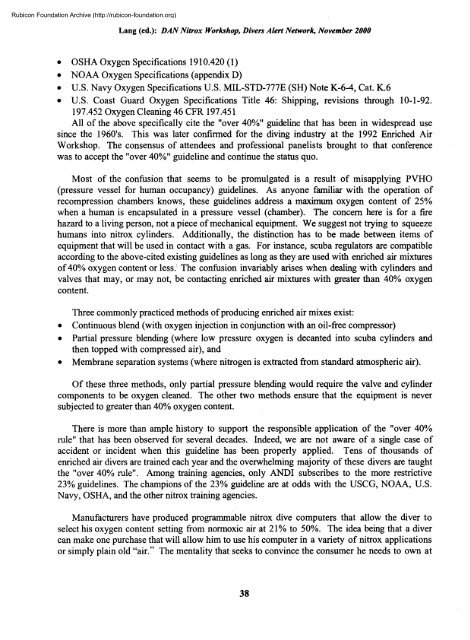Nitrox workshop dings - Divers Alert Network
Nitrox workshop dings - Divers Alert Network
Nitrox workshop dings - Divers Alert Network
Create successful ePaper yourself
Turn your PDF publications into a flip-book with our unique Google optimized e-Paper software.
Rubicon Foundation Archive (http://rubicon-foundation.org)Lang (ed.): DAN <strong>Nitrox</strong> Workshop, <strong>Divers</strong> <strong>Alert</strong> <strong>Network</strong>, November 2000• OSHA Oxygen Specifications 1910.420 (1)• NOAA Oxygen Specifications (appendix D)• U.S. Navy Oxygen Specifications U.S. MIL-STD-777E (SH) Note K-6-4, Cat. K.6• U.S. Coast Guard Oxygen Specifications Title 46: Shipping, revisions through 10-1-92.197.452 Oxygen Cleaning 46 CFR 197.451All of the above specifically cite the "over 40%" guideline that has been in widespread usesince the 1960's. This was later confirmed for the diving industry at the 1992 Enriched AirWorkshop. The consensus of attendees and professional panelists brought to that conferencewas to accept the "over 40%" guideline and continue the status quo.Most of the confusion that seems to be promulgated is a result of misapplying PVHO(pressure vessel for human occupancy) guidelines. As anyone familiar with the operation ofrecompression chambers knows, these guidelines address a maximum oxygen content of 25%when a human is encapsulated in a pressure vessel (chamber). The concern here is for a firehazard to a living person, not a piece of mechanical equipment. We suggest not trying to squeezehumans into nitrox cylinders. Additionally, the distinction has to be made between items ofequipment that will be used in contact with a gas. For instance, scuba regulators are compatibleaccording to the above-cited existing guidelines as long as they are used with enriched air mixturesof 40% oxygen content or less. The confusion invariably arises when dealing with cylinders andvalves that may, or may not, be contacting enriched air mixtures with greater than 40% oxygencontent.Three commonly practiced methods of producing enriched air mixes exist:• Continuous blend (with oxygen injection in conjunction with an oil-free compressor)• Partial pressure blending (where low pressure oxygen is decanted into scuba cylinders andthen topped with compressed air), and• Membrane separation systems (where nitrogen is extracted from standard atmospheric air).Of these three methods, only partial pressure blending would require the valve and cylindercomponents to be oxygen cleaned. The other two methods ensure that the equipment is neversubjected to greater than 40% oxygen content.There is more than ample history to support the responsible application of the "over 40%rule" that has been observed for several decades. Indeed, we are not aware of a single case ofaccident or incident when this guideline has been properly applied. Tens of thousands ofenriched air divers are trained each year and the overwhelming majority of these divers are taughtthe "over 40% rule". Among training agencies, only ANDI subscribes to the more restrictive23% guidelines. The champions of the 23% guideline are at odds with the USCG, NOAA, U.S.Navy, OSHA, and the other nitrox training agencies.Manufacturers have produced programmable nitrox dive computers that allow the diver toselect his oxygen content setting from normoxic air at 21% to 50%. The idea being that a divercan make one purchase that will allow him to use his computer in a variety of nitrox applicationsor simply plain old "air." The mentality that seeks to convince the consumer he needs to own at38
















